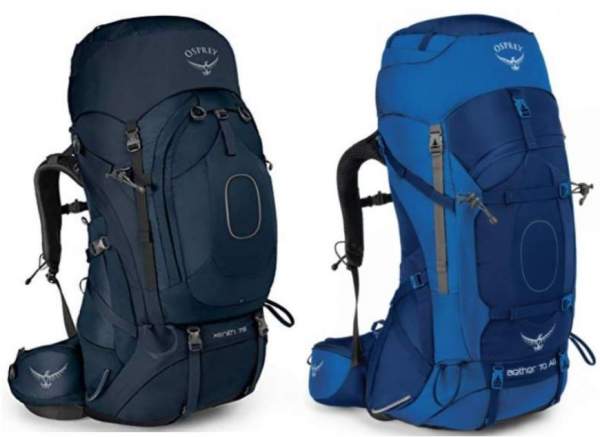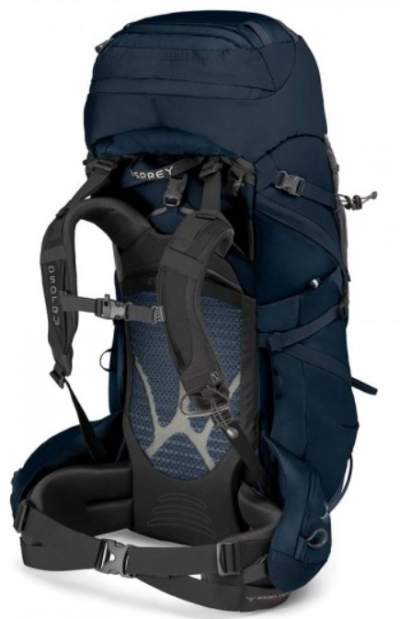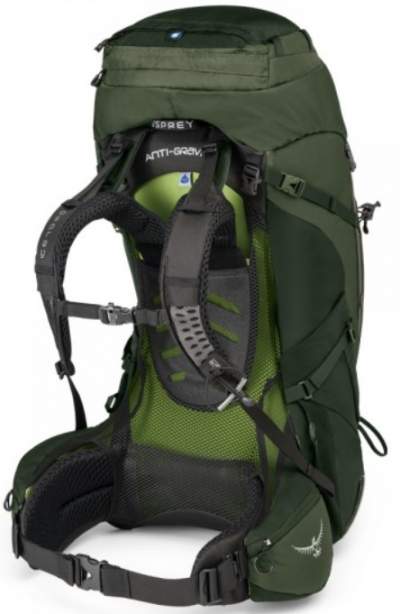Here I give a comparison Osprey Xenith vs Osprey Aether backpacks and come to the conclusion that overall features are better in the Xenith series.

Osprey Xenith series has been updated in 2018 so now it shares more features with the Aether packs than before, but those are still rather different packs.
The Xenith series includes the Xenith 75, Xenith 88, and Xenith 105 packs, while the Aether series includes Aether 60, Aether 70, and Aether 85 packs. So these are the largest backpacks built by Osprey so far. As you realize, there is an overlapping in the sizes, therefore it makes sense making a comparison if you are in search for a pack in the range of 70 – 80 liters.
Osprey Xenith series
Here are the basic features which you have in the Osprey Xenith packs:
- Built in 3 sizes within each of the nominal 75, 88, and 105 sizes. This means you have M, L, and XL sizes for each of these. To see what I mean, for example, the Xenith 75 pack has the sizes of 75, 79, and 83 liters, and those are the M, L, and XL sizes for this model. The same is with the other two models of 88 and 105 liters.
- BioForm hip belt. This means that the belt forms to your body due to the body heat.
- AirScape back panel and suspension system. The meaning is that you have a ridged back panel covered by a very breathable mesh.
- 3 access points to the main compartment, from the top, and from the two sides. You also have access through the bottom compartment.
- Removable lid which transforms into the DayLid day pack. This is a new feature introduced in the 2018 version. This is an incredibly functional daypack which is without a match on the market.
- 9 pockets in total.
- Adjustable torso size with Velcro tab. This allows for a really perfect fit.
- Weight capacity: 70 lb (32 kg).
- ErgoPull design on the hip belt. This implies that you have dual front straps on both sides of the belt and they provide the best hugging of the hip bones.
- External reservoir sleeve.
- There is no rain cover included.
A few more details you can see in this short video by Osprey:
Osprey Aether series
The most important features are as follows:
- Built in 4 sizes within each of the nominal 60 and 70 liters size, and in 3 sizes for the largest 85 liters pack.
- BioForm hip belt. So this is the same as in the Xenith series.
- AG back panel and suspension. Well, I assume you know about it already. If not, this is what they call the anti-gravity design, unique to several series by Osprey.
- 2 access points to the main compartment. The size of 60 liters has the top and side access. The sizes of 70 and 85 liters have the top and front access. All of them also have access through the bottom compartment.
- Removable lid which transforms into the DayLid day pack. So this is the same as in the Xenith series.
- 7 pockets in total.
- Adjustable torso size with Velcro tab.
- Weight capacity: 60 lb (27 kg).
- Dual front StraightJacket compression. This feature is unique to this series of Osprey.
- Attachment points for the Osprey Daylite pack, Note that several Osprey series have such a feature.
- Internal reservoir sleeve.
- No rain cover. Note that the EU version comes with a rain cover, but without the daypack.
More about the Aether packs please see in this video:
Below are the packs from the two series, and the pictures show the suspension which is with many different details:
So which is better?
Here is my summary table, and below I give the reasons for these plus and minus votes:
Harness
Hip belt
Ventilation
Attachment points
Pockets
Volume/Weight ratio
Weight capacity
Access points
Reservoir sleeve
Price
Osprey Xenith
Osprey Aether
The harness: There is no much difference here, both series have very similar adjustability options and other details.
The hip belt: I have no doubts here. Both series have the BioForm system in place, which is the best of the best for heavy loads, yet the extra ErgoPull system in the Xenith packs adds a lot to their comfort. This is the best design currently on the market, but note that you have it also in some other brands, without the same name of course.
Ventilation: The AG suspension in the Aether series definitely offers a better airflow from all sides. But see the comment below by Marcin, he and his friend did a nice comparison of the packs. So my conclusion may be wrong.
The pockets: The Xenith packs have more pockets, but this is not only about the number, they are very functional as well.
Volume/Weight ratio is very close in both series, around 30 liters/kg, which is a great value indeed. So there is no a winner here.
Weight capacity: The Xenith’s declared capacity is bigger so the winner is clear.
The access points: You have one more in the Xenith packs, they have access from both sides and from the top.
The reservoir sleeve: Having an external reservoir sleeve is an advantage, you do not have to mess with the stuff in the main compartment when you refill. So the Xenith is a clear winner.
The price: As of the moment of writing this text, the prices for the Aether AG 70 and the Xenith 75 are almost the same, and these are expensive packs. This may be different when you read this text so please check the links.
What about Osprey Xena vs Osprey Ariel packs?
As you probably know, they build the Xena women-specific packs corresponding to Xenith packs for men, and also Ariel women-specific packs parallel to the Aether men’s packs.
The Xenith-Xena and Aether-Ariel features are generally the same, so Xena packs would also receive a better rating than Ariel packs, check this Xena 70 review to see more.
What do you think?
I hope I did not miss anything important in the features and the comparison presented above. So my conclusion is that Xenith-Xena packs are better than Aether-Ariel series. What do you think? Please share your thoughts here.
Thank you for reading. Please use the comment box below in the case of comments or questions.


Marcin says
I use the waterblader sleeves as storage for my Ipad Pro anyway because I simple dont use the hydration bladers.
AG vs Airscape system. I have the Xenith 88 and going uphill I haved less wet t-shirt then when I was going downhill with the Aether 85 AG. Maybe U have right in terms that the AG works better with the smaller sized Aether packs. In summer time I’m almost every weekend on trail and the Airscape system works great for me but this is one man opinion.
When I plan a trip with friends we always try new things etc. and compare and share our experience. When somebody say that he disagree with something then we just swap gear, tents, stoves etc. For example from the moment that I buy my first Hilleberg tent I stayed with the Hilleberg brand since then. Now I have Kaitum 2GT. This tent packed weight is 3,8kg so is not ideal for solo adventure but I like the space and comfort. In warmer climate I roll the 2 vestibule and have great airflo and in colder climate I have great protection from the elements. So when my friend say that he love his MSR Hubba Hubba NX 2p I challenged him to go out in heavy storm weather. The MSR have a 1200mm rating so he stayed perfectly dry for 6hours when the water start to penetrate the rainfall. I stayed dry in Hilleberg. So I don’t say the MSR is bad tent but when U plan 2 week adventure and u encounter different weather for me is important that I can trust my gear in different situations. So what works for one person doesn’t necessarily means that another person will think the same. So AG vs Airscape doesn’t really have a winner here. Under 20kg maybe AG and above 20kg Airscape?
Jovo says
Hi Marcin, it is a real pleasure to read your detailed comment. I like what you are saying about exchanging gear and then comparing. You are most likely right about AG for smaller packs and Airscape for larger.
It seems that Osprey is abandoning the AG design completely, I wrote about this in a separate text. So it may be that Airscape is a winner after all.
I wonder if you have ever tried Deuter Futura Vario or their new version Air Trek which is very similar. I ordered the Futura Vario 50 + 10 recently because of its great discount price. I am right now in the mountains and just came back from a day tour where I used this pack because of lots of equipment, we still have snow on high peaks and gullies. I am delighted with its ventilation. I knew this even before as I have been using these packs for decades already. But I had 4 big climbs in 6 days and the pack worked perfectly.
Marcin says
Great review. I was lucky to try both backpacks during my weekend trip with my friends. I carry the Xenith 88 one way and my friend Aether 85 AG on the way back. We switch not only backpacks but the gear to. So is maybe worth to mention that when I pack all my gear to Aether 85 AG I haved some problems to pack everything although Xenith 88 and Aether 85 are almost the same size I think because the Xenith have the external hydration sleeve you can squeeze more stuff inside. I use the hydration sleeve as a great storage for my load Pro anyway. The water blades get quickly smeely even if U clean the blades regularly. anyway I haved some room left in my Xenith but with Aether I must to release the compression straps almost to the end. But I was able to fit everything anyway.
What I find about this review is that here the AG vs Airsace is better in terms of ventilation but my back and this was less wet when I was wearing the Xenith so ……
What I think U can make a nice comparison about the newest Aether AG vs Aether Pro vs Aether Plus.
Jovo says
Thank you so much Marcin, what a nice way to compare the two packs! I do not think it can be done better than what you two did. This is why your report is so valuable. What you write about the smelly water bladers also resonates with me, I think the same.
It is very puzzling what you write about the ventilation experience. I would certainly not argue with you about this. But I am indeed puzzled why this was so. My only guess is that the weight was too much for the AG design. I have always claimed that this AG thing is much better suited for smaller packs than for the largest they have. I added a sentence in the comparison text pointing to your comment.
I have a comparison Ariel Pro vs Ariel AG, so this is about packs for women but they are the same as the Aether packs for men, so the conclusion is the same.
I assume you know that Osprey is abandoning the Aether & Ariel AG, so they have a non-AG version launched for this year. As for the Aether Plus series, you can see in my text Osprey Aether & Ariel Plus vs Osprey Xenith & Xena packs.
I also have a comparison of Osprey Aether & Ariel Plus vs Osprey Xenith & Xena packs.
Thank you again for your comment, I am simply delighted with what you have done.